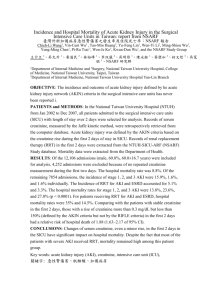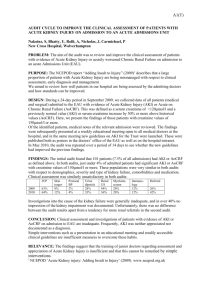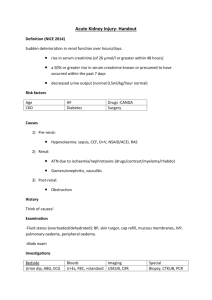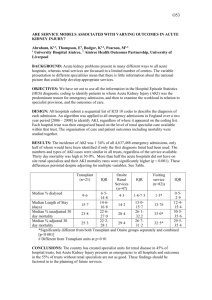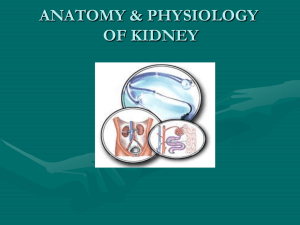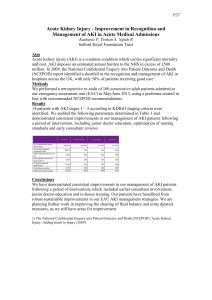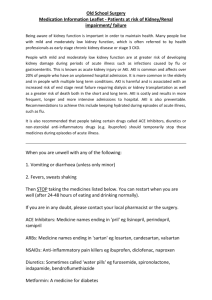Document 13405099
advertisement
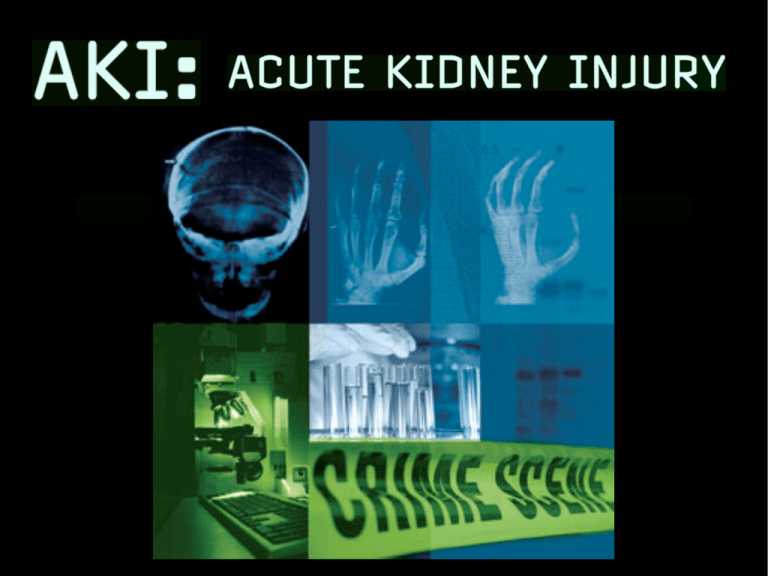
AKI Diagnosis Pathogenesis Therapy John R. Prowle MSc MB BChir MRCP FFICM Consultant Intensivist Royal London Hospital Summary • Early diagnosis of AKI is difficult • Pathogenesis is multifactorial • Maintain CO, BP and remove nephrotoxins • Do no harm • Supportive RRT if indicated • CRRT in the ICU Functions of the Kidney • • Salt, Water and Acid-base balance • • • • • • Excretion of Nitrogenous End Products • • • • • • Water Sodium Potassium Bicarbonate Magnesium Phosphate Urea Creatinine Uric acid Amines Guanidine derivatives Endocrine / Metabolic • • • Renin Erythropoetin 1,25-DHCC Acute & Chronic Consequences of Renal Dysfunction • Salt, Water and Acid-base balance • • • • • • • Oedema, CHF, Hypertension Hyperkalaemia Acidosis, Osteodystrophy Hypermagnesemia Hyperphosphataemia, Osteodystrophy Excretion of Nitrogenous End Products • • Fluid retention, Hyponatraemia Anorexia, Nausea, Puritis, Pericarditis, Polyneuropathy, Encephalopathy, Platelet dysfunction. Endocrine / Metabolic • • • Hypertension Anaemia Osteomalcia, Osteodystrophy Case #1 • 25 yr old male presents with a four hour history of headache confusion and non-blanching skin rash. • He was well the previous day • BP 95/40 HR 130 T 38.1 RR 35 • Creatinine 150 • What’s was his likely baseline creatinine? • Does he have AKI? - How Severe? • He admitted to ICU, after 18hr his Creat is 300 and he’s passed 200ml of Urine. He’s Intubated, on 0.8mcg/kg/ min Noradrenaline and has received 5L of Fluid. • How severe is his AKI now? • Has his GFR fallen since admission? • Will he need RRT? Case #2 • 80yr old male falls and fractures his hip • His ACE-In was continued despite BP 105/45 and a stat dose of Voltarol for pain on the ward. • He waits 48hr NBM for his hemiarthroplasty • He’s severely hypotensive intra-operatively with cement insertion • He admitted to HDU post-operatively for BP support • He has a cough with green sputum and R basal creps when he arrives in HDU Case #2 cont • Admission and day 1 Creat was 80 • What was his baseline GFR? • Does he have CKD? • Creat on HDU admission was 135 • What’s his GFR?? • Can we classify the severity of his AKI? • Will he need RRT? • His BP is 85/35 despite 2L of iv fluid, his UO is 5ml/hr • How should we treat his hypotension? AKI: Diagnosis • Sudden and sustained decrease in Glomerular Filtration Rate leading to accumulation of Urea and other toxins in the bloodstream. • A loose and not terribly useful definition. GFR & Creatinine • Steady State IN = OUT • Clearance x [Creatinine] = Generation Rate • GFR α 1/Creatinine • Steady State • Basis of eGFR • eGFR is only valid in Steady State • When in new steady state a doubling of Creatinine implies a halving of GFR. Steady State: In = Out G =K.Cr G K= Cr Double Creatinine = Half GFR Creatinine Production Creatinine GFR and Plasma Creatinine in Steady State Position of Curve is Shifted to Left by Lower Muscle Mass GFR & Creatinine • Creatinine generation rate (G) determines relationship between GFR and Creatinine in steady state and rate of rise in creatinine in AKI • Age, Sex, Race, Diet, Muscle Mass & Liver function determine G. • G is acute affected by acute illness. • Changes in volume of distribution (V) may also acutely alter [Creatinine]. Cases - Baseline • A 25 yr old male might typically have a GFR of 120ml/min and a Creatinine of 80µmol/L. • A 80yr old man with a Creatinine of 80 would have a GFR of around 65ml/min. • Timing and generation rate deterimine significant of acute creatinine changes. 100 50 0 Creatinine 150 200 25 yr old man whose GFR acutely falls from 120 to 60 ml/min 0 10 20 30 time (hrs) 40 50 100 50 0 Creatinine 150 200 80 yr old man whose GFR acutely falls from 65 to 32.5 ml/min 0 10 20 30 time (hrs) 40 50 0 10 20 30 time (hrs) 40 50 0 50 100 Creatinine 150 200 300 200 100 0 Creatinine 400 500 600 20 yr old man whose GFR acutely falls from 120 to 10 ml/min 0 10 20 30 time (hrs) 40 50 300 200 100 0 Creatinine 400 500 600 80 yr old man whose GFR acutely falls from 65 to 10 ml/min 0 10 20 30 time (hrs) 40 50 300 200 100 0 Creatinine 400 500 600 80 yr old man whose GFR acutely falls from 65 to 10 ml/min with a 1/3 fall in G 0 10 20 30 time (hrs) 40 50 Oliguria “Pre-Renal Failure” “Acute Renal Success” Appropriate renal salt and water conservation “Acute Renal Success”. Reversible reduction in Renal Blood Flow and decreased GFR “Pre-Renal Failure”. Sustained reduction in GFR in Acute Kidney Injury. AKI Oliguria AKI? ADH, Sympathetic and ReninAngiotensin responses to Pain and Injury may trigger salt and water conser vation even when blood pressure, cardiac output and volume status are adequate. AKI Oliguria? Loss of concentrating capacity in acute and chronic kidney disease or with diuretic therapy. If maximal concentrating capacity is low oliguria will only occur when GFR has fallen to a very low level. Summary.... • Elevated Creatinine and Sustained Oliguria are late consequences of AKI. • This has implications for treatment. AKI: Epidemiology Figure 2 Percentage distribution of causes of acute renal failure in (A) non-ICU and (B) ICU settings Modified with permission from Liano F et al. (1998) The spectrum of acute renal failure in the intensive care unit compared with that seen in other settings. The Madrid Acute Renal Failure Study Group. Kidney Int Suppl 66: S16–S24. © (1998) Nature Publishing Group. Lameire N et al. (2006) The changing epidemiology of acute renal failure Nat Clin Pract Neprol 2: 364–377 doi:10.1038/ncpneph0218 AKI: Pathogenesis • AKI rapidly reversible with restoration of haemodynamic insult. • “Pre-renal” • Sustained AKI persisting for days to weeks after removal of acute insult. • “ATN” / Tubular Injury But Don’t Forget Nephrologists and Urologists are Occasionally Useful • Active urinary sediment - ?GN • Interstitial Nephritis • Drugs • Obstruction • Anuria - Obstruction until proven otherwise AKI: Pathogenesis • Haemodynamic changes affecting glomerular ultrafiltration. • Ischaemia - Local • Microvascular injury. • Nephrotoxins. • Predisposition • CKD, Cardiac Failure, DM Prowle JR, et al. Nat Rev Nephrol 6, 107-15 (2010). Nephron Anatomy O2 Tension Blood Flow 13 80% 6.6 10-15% 5-10% 1.5 AKI is a multifactorial process affecting tubular function in areas of baseline vulnerability • Cardiac • Vasodilatory • Nephrotoxic • ↓ RPP • ↓ RPP • Tubular Injury • ↓ RBF • →↑↓RBF • Vasoconstriction • ↓ GFR • ↓ GFR • Ischaemia • Impaired autoregulation • Impaired autoregulation • Impaired autoregulation • Intra-renal shunting • Microvascular injury in sepsis OVERLAP Nephrotoxins • Direct cellular injury (Aminoglycosides, Pigment, Contrast, Osmotic Injury) • Vasoconstrictors (Contrast, NSAIDs, CNIs) • Tubular obstruction (Urate, Acyclovir) Events in endothelial cell activation, injury, and reduced microvascular flow Sharfuddin, A. A. & Molitoris, B. A. (2011) Pathophysiology of ischemic acute kidney injury Nat. Rev. Nephrol. doi:10.1038/nrneph.2011.16 Cellular Processes in AKI Sharfuddin, A. A. & Molitoris, B. A. (2011) Pathophysiology of ischemic acute kidney injury Nat. Rev. Nephrol. doi:10.1038/nrneph.2011.16 Tubular Injury and GFR Pathogenesis of AKI - Cases • Case #1 • Severe sepsis • Hyperdynamic shock • high flow low pressure • Altered microvascular blood flow, endothelial activation, microthrombi and interstitial oedema • Tubular injury • Case #2 • Multifactorial • Age-related CKD • Hypotension with inadequate cardiac reserve • Ischaemia • Nephrotoxins • Sepsis AKI: Treatment Prowle JR & Bellomo R: Acute Kidney Injury: Specific Interventions and Drugs. In Management of Acute Kidney Problems. Springer-Verlag, 2010, p. 229-239 Prowle JR & Bellomo R: Acute Kidney Injury: Specific Interventions and Drugs. In Management of Acute Kidney Problems. Springer-Verlag, 2010, p. 229-239 Late diagnosis prevents effective treatment • Ensure Adequate Cardiac Output • Ensure Adequate Renal Perfusion Pressure • Remove Nephrotoxins • Avoid secondary injury • Biomarkers of AKI AKI: Therapy Supportive treatment Mechanisms involved in the renal responses to intravenous and renal artery infusions of noradrenaline in conscious dogs. Anderson WP, Korner PI, Selig SE J Physiol 1981, 321:21-30. Norepinephrine or dopamine for the treatment of hyperdynamic septic shock? Martin C, Papazian L, Perrin G, Gouin F: Chest 1993, 103:1826-1831 First do no harm! Fluid Overload Prowle JR, et al. Nat Rev Nephrol 6, 107-15 (2010). Cases - Treatment • Withdrawal of nephrotoxins • Resuscitation to perfusion guided endpoint • Cardiac index, Stroke volume, Lactate, ScvO2 • Noradrenaline to MAP 60 to 75 • Treat sepsis • Avoid secondary injury • Remain oliguric? • Established tubular injury takes time to reverse Renal Replacement Therapy in the ICU To maintain homeostasis while patient and kidney function recovers. Indications • Refractory: • hyperkalaemia • acidaemia • fluid overload • uraemia • oliguria • dysnatraemia, toxin removal, temperature extremes, sepsis • if possible in anticipation of emergent need Indications for RRT in the RENAL Study N Engl J Med 2009; 361:1627-1638 • Oliguria (urine output <100 ml in a 6-hour period) • unresponsive to fluid resuscitation measures • Potassium concentration >6.5 mmol • Severe acidemia (pH <7.2) • Urea >25 mmol per liter • Creatinine concentration >300 μmol per liter • The presence of clinically significant organ edema Cases: Indications for RRT • Case #1 • Case #2 • UO 25ml/ml • UO 5-10ml/hr • Creat 300 Urea 22 • Creat 200 Urea 27 • Lactate 5 Bicarb 17 • Lactate 2 pH 7.34 • PaCO2 6.7 pH 7.15 • K+ 5.2 • K+ 5.8 • FB +7L yesterday • Ventilated 60% O2 • Needing CPAP PEEP 12 PaO2 8.6 • Albumin 19 • Ileus - Surgeon suggests TPN Requirements • A Plan • Machine • A filter/dialyzer • Nurse • Adequate Vascular Access • Blood pressure and Cardiac Output • Replacement/Dialysis fluid • Monitoring and point of care testing • Anticoagulation Semi-permeable membrane First Practicable Dialyser - Kloff 1945 Sausage skin Rotating Drum Fluid bath Modern CRRT Device Membrane Roller Pump Fluid Molecular movement across membrane •Convection –With bulk fluid movement –Pressure gradient •Diffusion –Due to random movement in solution –Concentration gradient –Molecular weight –Thermal energy Ultrafiltration with Convection Diffusion Ultrafiltration with Convection Diffusion Solute clearance • Dialysis can be very efficient and effectively clear all small solutes with a sufficient dialysate flow rate – Requires a small amount of ultrafiltration equal to need for fluid removal • Convection (filtration) solute clearance is limited by amount of filtration performed – Blood cannot be totally cleaned as 100% of plasma cannot be filtered – significant removal of solute requires filtration above needs for fluid removal necessitating use of a replacement solution • Both therapies regularise electrolyte concentrations by using a buffered salt solution as dialysate or replacement solution. Dialysis vs Filtration • Dialysis can be more efficient • especially for small molecules • Filtration can be more effective at removing larger molecules, up to membrane cut-off • but total clearances may be limited by achievable filtration rate • Haemodiafiltration or High Flux Continuous Haemodialysis offer some of the benefits of both Forms of Continuous Renal Replacement Therapy (CRRT) Clearances on Continuous Therapy Amount of fluid collecting in effluent bag per min approximates clearance. A Dose of 25ml/kg/hr is justified by current evidence. Trouble-shooting CRRT • The nursing staff are the experts • Adequate blood flow rate is essential • Usually the vascath is the problem not the anticoagulation • Right line, right site, right length • RIJ>Femoral>LIJ • Avoid SCV if possible • Need 24cm+ lines for femoral Summary • Early diagnosis of AKI is difficult • Pathogenesis is multifactorial • Maintain CO, BP and remove nephrotoxins • Do no harm • Supportive RRT if indicated • CRRT in the ICU Oh, dear God! This man's kidney's have exploded! There's nothing left!
